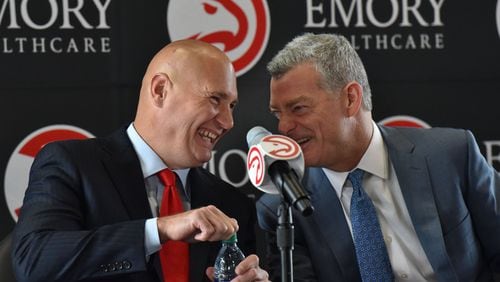The Hawks’ new general manager helped build one of the greatest teams ever, which makes for a snappy bullet point on the ol’ resume. We can’t know if Travis Schlenk will seek to remake the local franchise in the exact image of the one he just served, though he'll surely be tempted. Because what Golden State has done has worked. Today's question: Is that method transferable?
Sports execs are shameless imitators, but no other NBA team regarded the Bulls of the ‘90s as a template because – as Phil Jackson said when asked why he hadn’t won more coach-of-the-year trophies – “I’ve got Michael Jordan.” The same applies to the Cavaliers: They’ve got LeBron James. The Warriors are different. They achieved eminence as a collective, not a one-man gang.
Of the core that lifted Golden State to the 2015 NBA title, three were lottery picks. Stephen Curry was the seventh man drafted in 2009; Klay Thompson was No. 11 two years later, Harrison Barnes No. 7 the year after that. Fun fact: The highest pick of the Warriors’ formative years was Ekpe Udoh, No. 6 in 2010.
Curry and Thompson were regarded as premier shooters, but they entered the NBA at a time when teams still built from the inside out. Golden State’s ascent would change that thinking. The aforementioned Udoh figured in the 2012 trade with Dallas that saw the Warriors sacrifice Monta Ellis, a scoring guard rendered superfluous by the burgeoning Splash Brothers, for center Andrew Bogut, who’d been No. 1 overall pick in 2005. (The No. 2 was Marvin Williams.)
Bogut’s defense helped the Warriors become good. The flowering of Draymond Green, the fifth player taken in Round 2 of 2012, made them special. To say that the Warriors expected Green to become the prototype for small-ball big men would be extending too much credit; they’d taken Festus Ezeli, a more conventional post player, five picks earlier. Green simply was better than anyone dreamed. (Curry was, too. We can credit Golden State for having the foresight to draft guys with massive potential.)
The Warriors’ front office is a curious mix. Bob Myers, who came aboard as assistant GM in 2011 and was promoted to GM a year later, was a deep-bench player at UCLA on Jim Harrick’s 1995 championship team and later a player agent. Principal owner Joe Lacob is a venture capitalist. Co-owner Peter Guber is a Hollywood producer. Last year Lacob bragged to the New York Times that Golden State was “light years ahead of probably every other team in structure, in planning, in how we’re going to go about things.” Dullards in other burgs offered hearty guffaws when Team Lightyears blew a 3-1 lead in the NBA finals.
To its credit, Golden State used that wrenching reversal as a spur to sign Kevin Durant. The Warriors had to shed two starters (Barnes and Bogut) to make room, but that was nothing for a team famous for its ability to juggle contracts. Curry signed an unbelievably team-friendly extension in 2012, leading to one of the league’s great incongruities: The fifth highest-paid Warrior was the NBA’s first unanimous MVP. Then again, Golden State could afford Andre Iguodala, MVP of the 2015 finals, largely because Curry came cheap.
If there’s a Warrior Way, it’s that – No Bad Contracts. In his introductory remarks here, Schlenk proclaimed the need for “flexibility” to land a superstar. But the only fully minted superstar to join Golden State was Durant, and if the Warriors hadn’t blown that 3-1 lead he’d probably have signed with Boston or stayed in Oklahoma City. Having cap space is one thing if you’re the Warriors and you have Curry and Thompson and Green and can say to Durant, “You’re our missing piece.” It’s different if you’re not and you don't and you can't.
The Bulls entered the 2010 offseason hoping LeBron and Chris Bosh would join Derrick Rose in Chicago. Dwyane Wade lured them to South Beach. The thought of bringing a title to long-suffering Cleveland then drew LeBron back home. The desire to be part of history pried Durant from OKC. The point being: Teams can scheme until the cows come home, but it’s the superstars who hold the power.
Golden State’s acquisition and cultivation of Curry/Thompson/Green changed a moribund franchise. The Hawks wouldn’t seem in a position to follow that path. Their young players aren't nearly that good, and they’ve exercised one lottery pick since Al Horford in 2007. (Spent on Taurean Prince, No. 12 in last year’s draft.) They’re picking 19th this time. The Warriors got good without a top-five draftee, but it wasn’t until Curry’s fourth season that the team made the playoffs. They assembled and adapted.
Still, assembling is more perilous the lower you draft, and adapting is easier if you’re moving from strength to strength. Golden State’s ascent will stand forever as one of the great reconstructions, which isn’t to say it’s a viable model. To do what the Warriors have done, you'd need a smallish guard to become the greatest shooter ever, an undersized power forward to grow into the best mesh player of this century and an already-minted superstar to say yes to your entreaty. Put simply, you'd need a lot of luck.







